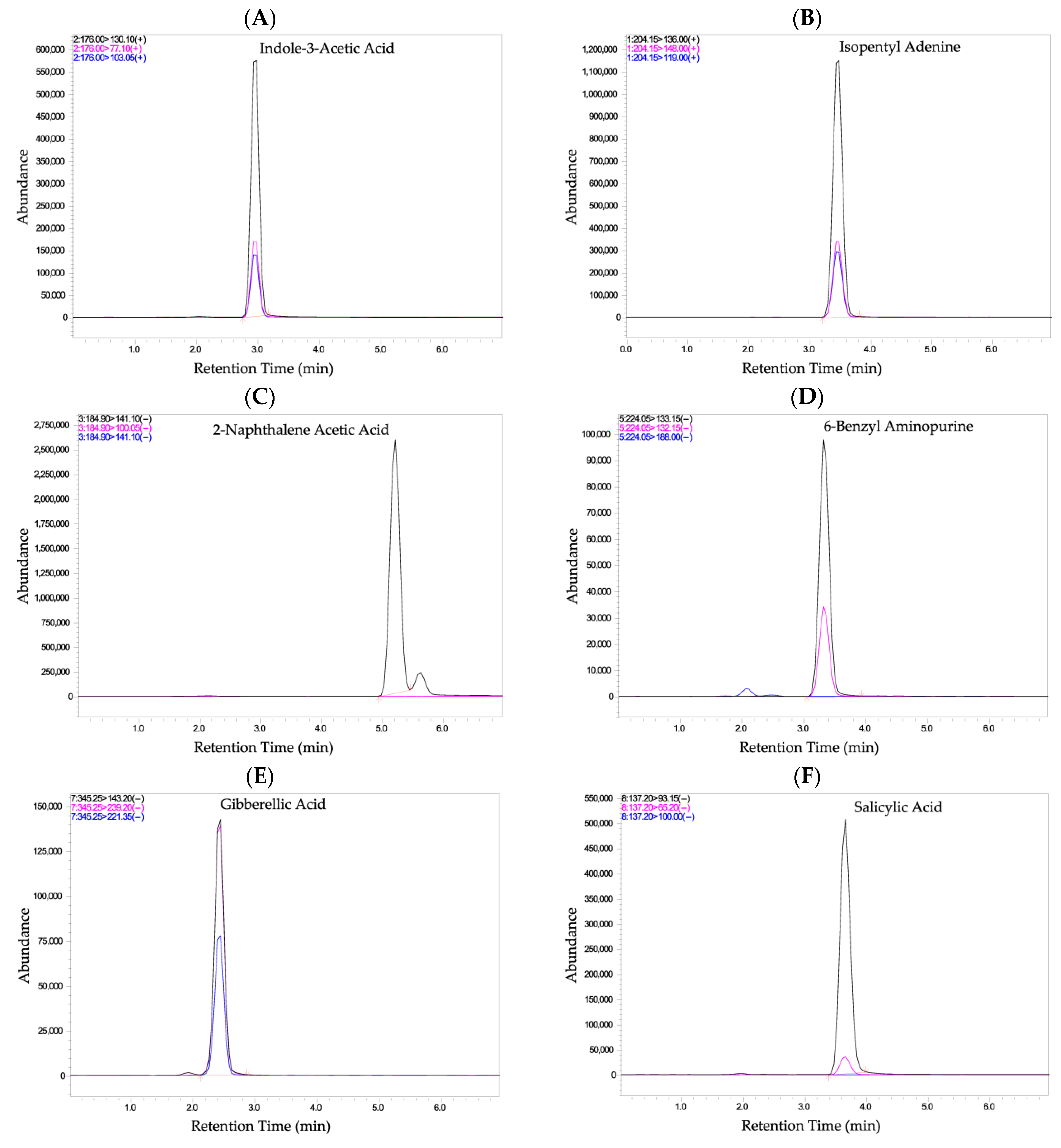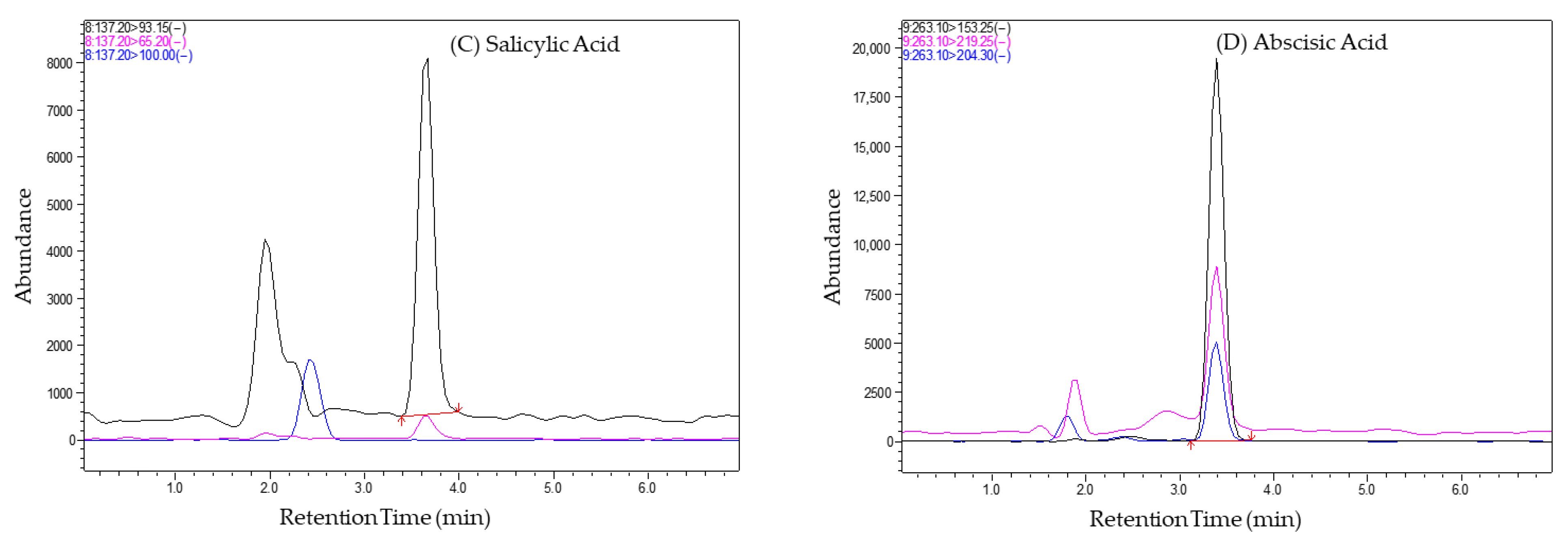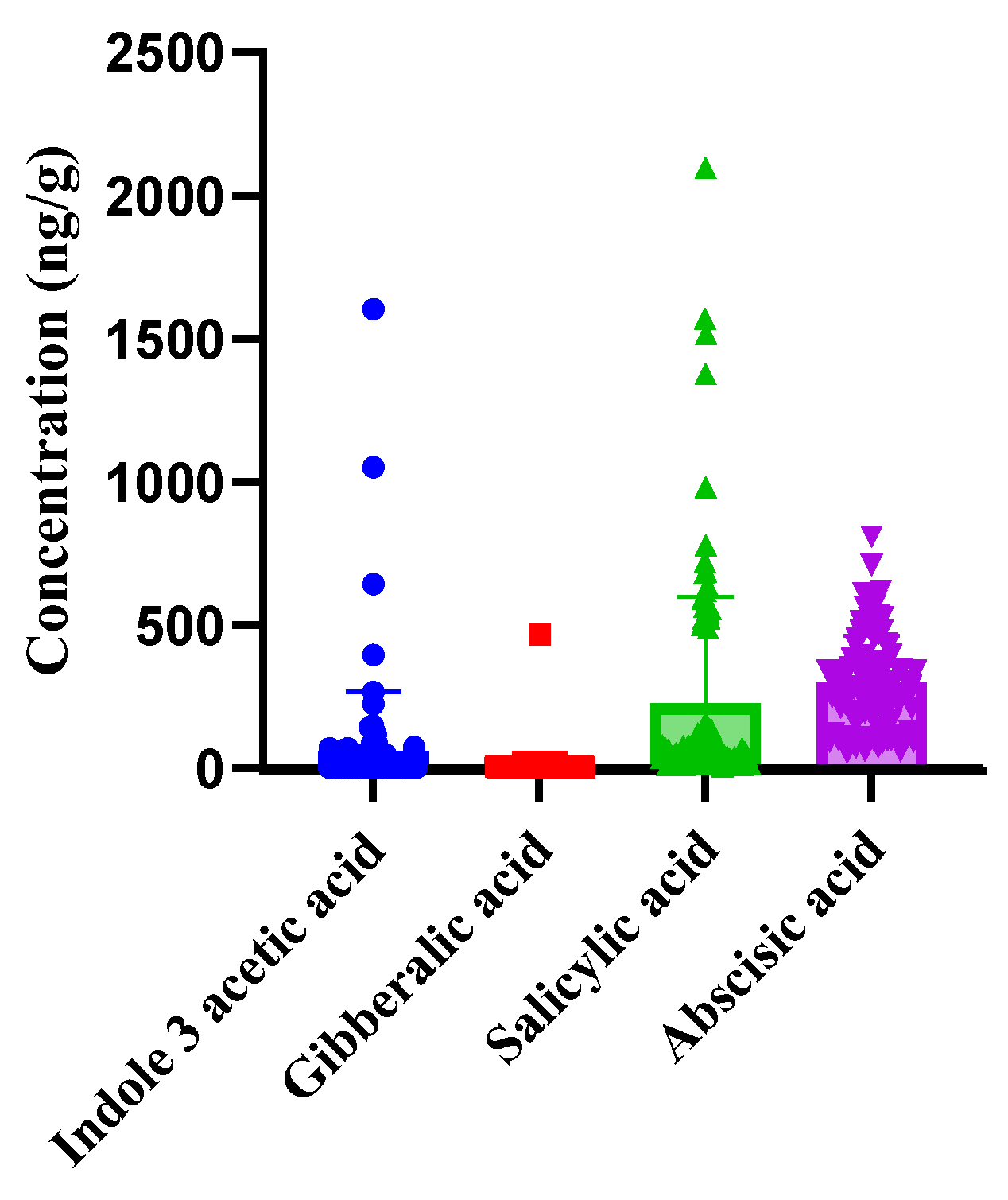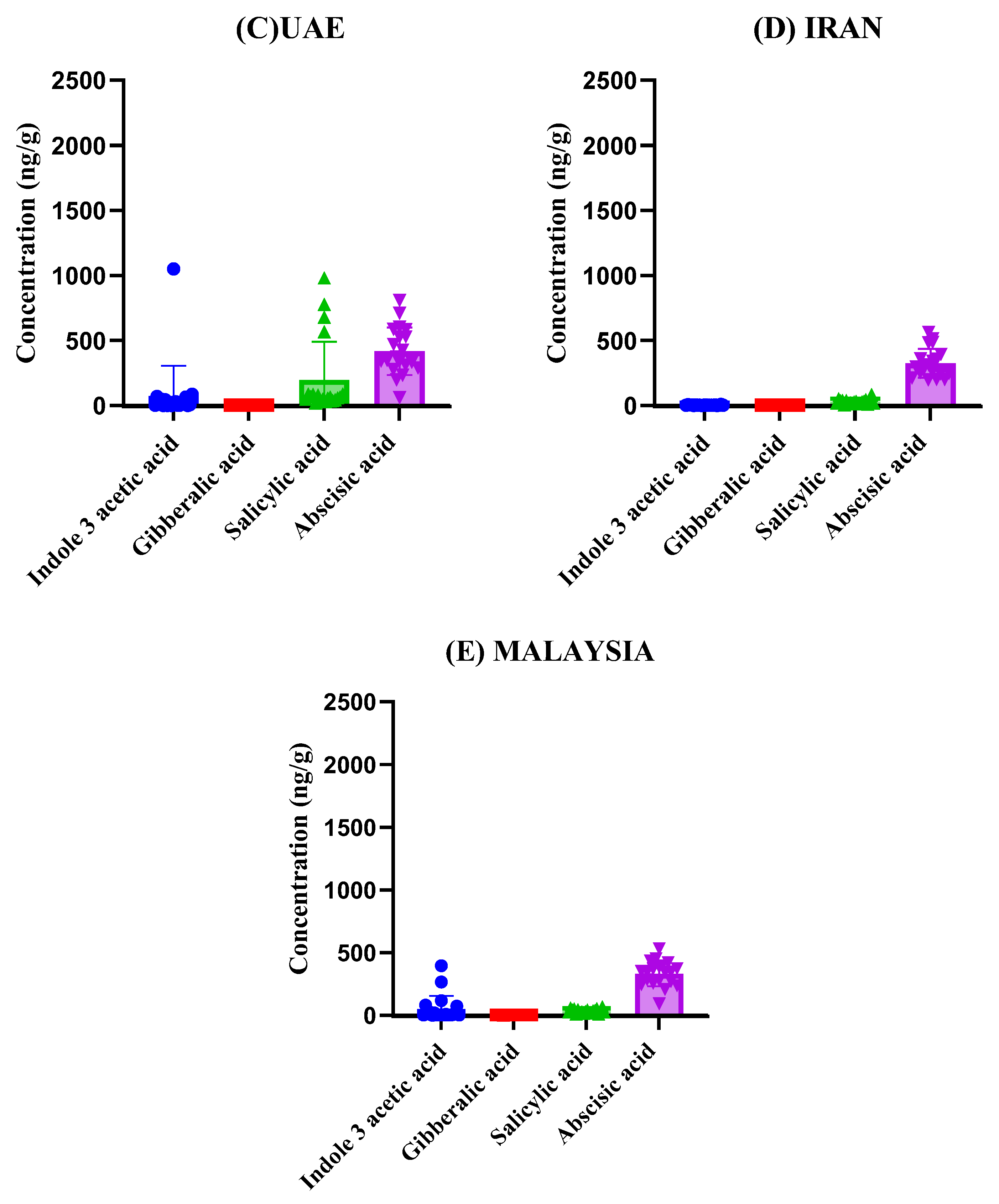Development and Validation of an LC–MS/MS Method for Quantifying Phytohormones Related to Tomato Shelf Life
Abstract
1. Background
2. Materials and Methods
2.1. Chemicals & Reagents
2.2. Preparation of Standard Solution
2.3. Tomato Plant Cultivation, Collection, and Sample Preparation
2.4. LC-MS/MS Analysis and Method Development
2.5. MS Tuning Procedure and Parameters
2.6. Method Validation
3. Results and Discussion
3.1. Method Validation Results
3.2. Sample Analysis
4. Conclusions
5. Future Prospects
Author Contributions
Funding
Institutional Review Board Statement
Informed Consent Statement
Data Availability Statement
Acknowledgments
Conflicts of Interest
References
- Pal, P.; Ansari, S.A.; Jalil, S.U.; Ansari, M.I. Regulatory Role of Phytohormones in Plant Growth and Development. In Plant Hormones in Crop Improvement; Elsevier: Amsterdam, The Netherlands, 2023; pp. 1–13. [Google Scholar]
- Asif, R.; Yasmin, R.; Mustafa, M.; Ambreen, A.; Mazhar, M.; Rehman, A.; Umbreen, S.; Ahmad, M. Phytohormones as Plant Growth Regulators and Safe Protectors against Biotic and Abiotic Stress. In Plant Hormones—Recent Advances, New Perspectives and Applications; IntechOpen: Rijeka, Croatia, 2022; pp. 115–130. [Google Scholar]
- Peres, A.L.G.; Soares, J.S.; Tavares, R.G.; Righetto, G.; Zullo, M.A.; Mandava, N.B.; Menossi, M. Brassinosteroids, the Sixth Class of Phytohormones: A Molecular View from the Discovery to Hormonal Interactions in Plant Development and Stress Adaptation. Int. J. Mol. Sci. 2019, 20, 331. [Google Scholar] [CrossRef]
- Zhao, B.; Liu, Q.; Wang, B.; Yuan, F. Roles of Phytohormones and Their Signaling Pathways in Leaf Development and Stress Responses. J. Agric. Food Chem. 2021, 69, 3566–3584. [Google Scholar] [CrossRef] [PubMed]
- Bhatt, D.; Nath, M.; Sharma, M.; Bhatt, M.D.; Bisht, D.S.; Butani, N.V. Role of Growth Regulators and Phytohormones in Overcoming Environmental Stress. In Protective Chemical Agents in the Amelioration of Plant Abiotic Stress: Biochemical and Molecular Perspectives; Academic Press: Cambridge, MA, USA, 2020; pp. 254–279. [Google Scholar]
- Bhatla, S.C.; Lal, M.A. Novel Plant Growth Regulators and Gaseous Signaling Molecules. In Plant Physiology, Development and Metabolism; Bhatla, S.C., Lal, M.A., Eds.; Springer Nature: Singapore, 2023; pp. 479–515. ISBN 978-981-99-5736-1. [Google Scholar]
- Kimura, S.; Sinha, N. Tomato (Solanum lycopersicum): A Model Fruit-Bearing Crop. Cold Spring Harb. Protoc. 2008, 2008, pdb-emo105. [Google Scholar] [CrossRef] [PubMed]
- Hakeem, M.K.; Elangovan, S.; Rafi, M.; George, S.; Shah, I.; Amiri, K.M.A. Advancing Antibiotic Residue Analysis: LC-MS/MS Methodology for Ticarcillin Degradation Products in Tomato Leaves. Antibiotics 2024, 13, 133. [Google Scholar] [CrossRef]
- Zhu, Z.; Luo, M.; Li, J.; Cui, B.; Liu, Z.; Fu, D.; Zhou, H.; Zhou, A. Comparative Transcriptome Analysis Reveals the Function of SlPRE2 in Multiple Phytohormones Biosynthesis, Signal Transduction and Stomatal Development in Tomato. Plant Cell Rep. 2023, 42, 921–937. [Google Scholar] [CrossRef] [PubMed]
- Wei, L.; Zhang, J.; Wei, S.; Hu, D.; Liu, Y.; Feng, L.; Li, C.; Qi, N.; Wang, C.; Liao, W. Nitric Oxide Enhanced Salt Stress Tolerance in Tomato Seedlings, Involving Phytohormone Equilibrium and Photosynthesis. Int. J. Mol. Sci. 2022, 23, 4539. [Google Scholar] [CrossRef]
- Waseem, M.; Aslam, M.M.; Shaheen, I. The DUF221 Domain-Containing (DDP) Genes Identification and Expression Analysis in Tomato under Abiotic and Phytohormone Stress. GM Crops Food 2021, 12, 586–599. [Google Scholar] [CrossRef]
- Ntatsi, G.; Savvas, D.; Ntatsi, G.; Kläring, H.-P.; Schwarz, D. Growth, Yield, and Metabolic Responses of Temperature-Stressed Tomato to Grafting onto Rootstocks Differing in Cold Tolerance. J. Amer. Soc. Hort. Sci. 2014, 39, 230–243. [Google Scholar] [CrossRef]
- Ntatsi, G.; Savvas, D.; Druege, U.; Schwarz, D. Contribution of Phytohormones in Alleviating the Impact of Sub-Optimal Temperature Stress on Grafted Tomato. Sci. Hortic. 2013, 149, 28–38. [Google Scholar] [CrossRef]
- Saleh, M.O.; Al-Bayati, A.H.I. Comparative Chemical Classification of Selected Species of the Solanaceae Family Growing Wild in Anbar Governorate. IOP Conf. Ser. Earth Environ. Sci. 2025, 1538, 012057. [Google Scholar] [CrossRef]
- Kowalczyk, T.; Merecz-Sadowska, A.; Rijo, P.; Mori, M.; Hatziantoniou, S.; Górski, K.; Szemraj, J.; Piekarski, J.; Śliwiński, T.; Bijak, M.; et al. Hidden in Plants—A Review of the Anticancer Potential of the Solanaceae Family in In Vitro and In Vivo Studies. Cancers 2022, 14, 1455. [Google Scholar] [CrossRef]
- Motti, R. The Solanaceae Family: Botanical Features and Diversity. In The Wild Solanums Genomes; Carputo, D., Aversano, R., Ercolano, M.R., Eds.; Springer International Publishing: Cham, Switzerland, 2021; pp. 1–9. ISBN 978-3-030-30343-3. [Google Scholar]
- Li, J.; Li, C.; Smith, S.M. Hormone Metabolism and Signaling in Plants; Academic Press: Cambridge, MA, USA, 2017; ISBN 0-12-811563-7. [Google Scholar]
- Yang, J.; Duan, G.; Li, C.; Liu, L.; Han, G.; Zhang, Y.; Wang, C. The Crosstalks between Jasmonic Acid and Other Plant Hormone Signaling Highlight the Involvement of Jasmonic Acid as a Core Component in Plant Response to Biotic and Abiotic Stresses. Front. Plant Sci. 2019, 10, 1349. [Google Scholar] [CrossRef] [PubMed]
- Driesen, E.; Van den Ende, W.; De Proft, M.; Saeys, W. Influence of Environmental Factors Light, CO2, Temperature, and Relative Humidity on Stomatal Opening and Development: A Review. Agronomy 2020, 10, 1975. [Google Scholar] [CrossRef]
- Balcke, G.U.; Handrick, V.; Bergau, N.; Fichtner, M.; Henning, A.; Stellmach, H.; Tissier, A.; Hause, B.; Frolov, A. An UPLC-MS/MS Method for Highly Sensitive High-Throughput Analysis of Phytohormones in Plant Tissues. Plant Methods 2012, 8, 47. [Google Scholar] [CrossRef] [PubMed]
- Almeida Trapp, M.; De Souza, G.D.; Rodrigues-Filho, E.; Boland, W.; Mithöfer, A. Validated Method for Phytohormone Quantification in Plants. Front. Plant Sci. 2014, 5, 417. [Google Scholar] [CrossRef]
- Su, Y.; Xia, S.; Wang, R.; Xiao, L. Phytohormonal Quantification Based on Biological Principles. Horm. Metab. Signal. Plants 2017, 13, 431–470. [Google Scholar]
- Sabagh, A.E.; Mbarki, S.; Hossain, A.; Iqbal, M.A.; Islam, M.S.; Raza, A.; Llanes, A.; Reginato, M.; Rahman, M.A.; Mahboob, W.; et al. Potential Role of Plant Growth Regulators in Administering Crucial Processes Against Abiotic Stresses. Front. Agron. 2021, 3, 648694. [Google Scholar] [CrossRef]
- Vaishnav, D.; Chowdhury, P. Types and Function of Phytohormone and Their Role in Stress. In Plant Abiotic Stress Responses and Tolerance Mechanisms; IntechOpen: Rijeka, Croatia, 2023; ISBN 1-80356-957-3. [Google Scholar]
- Mohanta, T.K.; Mohanta, Y.K.; Yadav, D.; Hashem, A.; Abd_Allah, E.F.; Al-Harrasi, A. Global Trends in Phytohormone Research: Google Trends Analysis Revealed African Countries Have Higher Demand for Phytohormone Information. Plants 2020, 9, 1248. [Google Scholar] [CrossRef]
- Ahmad, B.; Qadir, S.U.; Dar, T.A.; Alam, P.; Yousuf, P.Y.; Ahmad, P. Karrikins: Smoke-Derived Phytohormones from Stress Alleviation to Signaling. J. Plant Growth Regul. 2023, 42, 4784–4796. [Google Scholar] [CrossRef]
- Sun, P.; Huang, Y.; Yang, X.; Liao, A.; Wu, J. The Role of Indole Derivative in the Growth of Plants: A Review. Front. Plant Sci. 2023, 13, 1120613. [Google Scholar] [CrossRef]
- Li, L.; Zheng, Q.; Jiang, W.; Xiao, N.; Zeng, F.; Chen, G.; Mak, M.; Chen, Z.-H.; Deng, F. Molecular Regulation and Evolution of Cytokinin Signaling in Plant Abiotic Stresses. Plant Cell Physiol. 2022, 63, 1787–1805. [Google Scholar] [CrossRef] [PubMed]
- Bajguz, A.; Piotrowska-Niczyporuk, A. Biosynthetic Pathways of Hormones in Plants. Metabolites 2023, 13, 884. [Google Scholar] [CrossRef] [PubMed]
- Salvi, P.; Manna, M.; Kaur, H.; Thakur, T.; Gandass, N.; Bhatt, D.; Muthamilarasan, M. Phytohormone Signaling and Crosstalk in Regulating Drought Stress Response in Plants. Plant Cell Rep. 2021, 40, 1305–1329. [Google Scholar] [CrossRef] [PubMed]
- Bhatla, S.C.; Lal, M.A. Secondary Metabolites. In Plant Physiology, Development and Metabolism; Springer: Berlin/Heidelberg, Germany, 2023; pp. 765–808. [Google Scholar]
- Hou, S.; Tsuda, K. Salicylic Acid and Jasmonic Acid Crosstalk in Plant Immunity. Essays Biochem. 2022, 66, 647–656. [Google Scholar] [CrossRef]
- Lindsey, K. Plant Peptide Hormones: The Long and the Short of It. Curr. Biol. 2001, 11, R741–R743. [Google Scholar] [CrossRef]
- Takahashi, F.; Suzuki, T.; Osakabe, Y.; Betsuyaku, S.; Kondo, Y.; Dohmae, N.; Fukuda, H.; Yamaguchi-Shinozaki, K.; Shinozaki, K. A Small Peptide Modulates Stomatal Control via Abscisic Acid in Long-Distance Signalling. Nature 2018, 556, 235–238. [Google Scholar] [CrossRef]
- Chiwocha, S.D.S.; Dixon, K.W.; Flematti, G.R.; Ghisalberti, E.L.; Merritt, D.J.; Nelson, D.C.; Riseborough, J.-A.M.; Smith, S.M.; Stevens, J.C. Karrikins: A New Family of Plant Growth Regulators in Smoke. Plant Sci. 2009, 177, 252–256. [Google Scholar] [CrossRef]
- Li, W.; Nguyen, K.H.; Chu, H.D.; Ha, C.V.; Watanabe, Y.; Osakabe, Y.; Leyva-González, M.A.; Sato, M.; Toyooka, K.; Voges, L.; et al. The Karrikin Receptor KAI2 Promotes Drought Resistance in Arabidopsis Thaliana. PLoS Genet. 2017, 13, e1007076. [Google Scholar] [CrossRef]
- Shapiro, A.D. Nitric Oxide Signaling in Plants. In Vitamins & Hormones; Litwack, G., Ed.; Plant Hormones; Academic Press: Cambridge, MA, USA, 2005; Volume 72, pp. 339–398. [Google Scholar]
- Pandey, S.; Ranade, S.A.; Nagar, P.K.; Kumar, N. Role of Polyamines and Ethylene as Modulators of Plant Senescence. J. Biosci. 2000, 25, 291–299. [Google Scholar] [CrossRef]
- Moschou, P.N.; Roubelakis-Angelakis, K.A. Polyamines and Programmed Cell Death. J. Exp. Bot. 2014, 65, 1285–1296. [Google Scholar] [CrossRef]
- Suliman, A.A.; Elkhawaga, F.A.; Zargar, M.; Bayat, M.; Pakina, E.; Abdelkader, M. Boosting Resilience and Efficiency of Tomato Fields to Heat Stress Tolerance Using Cytokinin (6-Benzylaminopurine). Horticulturae 2024, 10, 170. [Google Scholar] [CrossRef]
- Narendar, M.; Sreenu, P.; Mustafa, M.; Shailaja, K. High Efficiency Callus-Mediated Regeneration in Corynandra Felina: A Medicinal Plant Endemic to Peninsular India. In Vegetos; Springer: Berlin/Heidelberg, Germany, 2024. [Google Scholar] [CrossRef]
- Zarea, M.J.; Karimi, N. Grain Yield and Quality of Wheat Are Improved through Post-Flowering Foliar Application of Zinc and 6-Benzylaminopurine under Water Deficit Condition. Front. Plant Sci. 2023, 13, 1068649. [Google Scholar] [CrossRef] [PubMed]
- Wang, L.; Zou, Y.; Kaw, H.Y.; Wang, G.; Sun, H.; Cai, L.; Li, C.; Meng, L.-Y.; Li, D. Recent Developments and Emerging Trends of Mass Spectrometric Methods in Plant Hormone Analysis: A Review. Plant Methods 2020, 16, 54. [Google Scholar] [CrossRef] [PubMed]
- Han, X.-F.; Chen, J.; Shi, Y.-P. N-Doped Carbon Nanotubes-Reinforced Hollow Fiber Solid-Phase Microextraction Coupled with High Performance Liquid Chromatography for the Determination of Phytohormones in Tomatoes. Talanta 2018, 185, 132–140. [Google Scholar] [CrossRef]
- Rawlinson, C.; Kamphuis, L.G.; Gummer, J.P.; Singh, K.B.; Trengove, R.D. A Rapid Method for Profiling of Volatile and Semi-Volatile Phytohormones Using Methyl Chloroformate Derivatisation and GC–MS. Metabolomics 2015, 11, 1922–1933. [Google Scholar] [CrossRef]
- Chu, J.; Fang, S.; Xin, P.; Guo, Z.; Chen, Y. Quantitative Analysis of Plant Hormones Based on LC-MS/MS. In Hormone Metabolism and Signaling in Plants; Academic Press: Cambridge, MA, USA, 2017; pp. 471–537. [Google Scholar]
- Yalçın, S.; Şükran Okudan, E.; Karakaş, Ö.; Önem, A.N.; Sözgen Başkan, K. Identification and Quantification of Some Phytohormones in Seaweeds Using UPLC-MS/MS. J. Liq. Chromatogr. Relat. Technol. 2019, 42, 475–484. [Google Scholar] [CrossRef]
- Taher, M.A.; Moniruzzaman, M.; Kama, S.; Jahan, F.; Khan, M. Development and Validation of Reverse Phase Liquid Chromatography Method for Quantifying Gibberellic Acid in Fertilizer Matrix. Available online: https://dx.doi.org/10.2139/ssrn.4549842 (accessed on 22 May 2025).
- Maoka, T. Carotenoids: Distribution, Function in Nature, and Analysis Using LC-Photodiode Array Detector (DAD)-MS and MS/MS System. Mass Spectrom. 2023, 12, A0133. [Google Scholar] [CrossRef]
- Balcerowicz, M.; Shetty, K.N.; Jones, A.M. Fluorescent Biosensors Illuminating Plant Hormone Research. Plant Physiol. 2021, 187, 590–602. [Google Scholar] [CrossRef]
- Chen, Y.; He, B.; Hu, M.; Bao, J.; Yan, W.; Han, X.; Ye, Y. Fluorescent Probes for Imaging and Detection of Plant Hormones and Their Receptors. Adv. Agrochem 2023, 3, 83–98. [Google Scholar] [CrossRef]
- Jon, C.-S.; Zou, Y.; Zhao, J.; Ri, H.-C.; Wang, L.; Kaw, H.Y.; Meng, L.-Y.; Shang, H.; Li, D. Simultaneous Determination of Multiple Phytohormones in Tomato by Ionic Liquid-Functionalized Carbon Fibers-Based Solid-Phase Microextraction Coupled with Liquid Chromatography-Mass Spectrometry. Anal. Chim. Acta 2020, 1137, 143–155. [Google Scholar] [CrossRef]
- Hakeem, M.K.; Maraqa, M.; Elangovan, S.K.; Saeed, E.E.; Mishra, A.K.; Hazzouri, K.M.; Shah, I.; Amiri, K.M.A. Innovative Determination of Phytohormones in Aloe Vera. Front. Chem. 2025, 12, 1490639. [Google Scholar] [CrossRef]
- Fu, J.; Chu, J.; Sun, X.; Wang, J.; Yan, C. Simple, Rapid, and Simultaneous Assay of Multiple Carboxyl Containing Phytohormones in Wounded Tomatoes by UPLC-MS/MS Using Single SPE Purification and Isotope Dilution. Anal. Sci. 2012, 28, 1081–1087. [Google Scholar] [CrossRef]
- Delatorre, C.; Rodríguez, A.; Rodríguez, L.; Majada, J.P.; Ordás, R.J.; Feito, I. Hormonal Profiling: Development of a Simple Method to Extract and Quantify Phytohormones in Complex Matrices by UHPLC–MS/MS. J. Chromatogr. B 2017, 1040, 239–249. [Google Scholar] [CrossRef] [PubMed]
- Khedr, T.; Ryad, L.; Youssef, A.O. Testing the Validity of Reference Standard Materials and Stock Solutions of Veterinary Drugs Using LC-MS/MS. Food Addit. Contam. Part A 2019, 36, 405–412. [Google Scholar] [CrossRef]
- Ito, S.; Tsukada, K. Matrix Effect and Correction by Standard Addition in Quantitative Liquid Chromatographic–Mass Spectrometric Analysis of Diarrhetic Shellfish Poisoning Toxins. J. Chromatogr. A 2002, 943, 39–46. [Google Scholar] [CrossRef] [PubMed]
- Yao, X.; Xia, N.; Meng, X.; Duan, C.; Pan, Q. A One-Step Polyphenol Removal Approach for Detection of Multiple Phytohormones from Grape Berry. Horticulturae 2022, 8, 548. [Google Scholar] [CrossRef]
- Šimura, J.; Antoniadi, I.; Široká, J.; Tarkowská, D.E.; Strnad, M.; Ljung, K.; Novák, O. Plant Hormonomics: Multiple Phytohormone Profiling by Targeted Metabolomics. Plant Physiol. 2018, 177, 476–489. [Google Scholar] [CrossRef]
- Jeong, M.-J.; Ko, B.J.; Kim, J.Y. Mass Spectrometry-Based Metabolomics Study for Delay Tomato Fruit Ripening by Sound Waves. J Anal Sci Technol 2023, 14, 27. [Google Scholar] [CrossRef]
- Zimmer, D. New US FDA Draft Guidance on Bioanalytical Method Validation versus Current FDA and EMA Guidelines: Chromatographic Methods and ISR. Bioanalysis 2014, 6, 13–19. [Google Scholar] [CrossRef]
- US Food and Drug Administration. Bioanalytical Method Validation. In Guidance for Industry; US Food and Drug Administration: Silver Spring, MD, USA, 2001. [Google Scholar]
- Sargent, M. Guide to Achieving Reliable Quantitative LC-MS Measurements; RSC Analytical Methods Committee: London, UK, 2013; p. 68. [Google Scholar]
- Commission Implementing Regulation (EU) 2021/808 on the Performance of Analytical Methods for Residues of Pharmacologically Active Substances Used in Food-Producing Animals and on the Interpretation of Results as Well as on the Methods to Be Used for Sampling and Repealing Decisions 2002/657/EC and 98/179/EC.|FAOLEX. Available online: https://www.fao.org/faolex/results/details/en/c/LEX-FAOC203999/ (accessed on 22 May 2025).
- Song, Y.; Dong, M.; Gu, J.; Jin, X.; Hu, Y.; Chen, F.; Qiao, Z.; Zhang, T. Synergistic Effects of Combined Foliar Fertilizers on Growth, Stress Tolerance, and Yield of High-Quality Japonica Rice. Int. J. Plant Prod. 2025, 19, 255–268. [Google Scholar] [CrossRef]
- Zhang, J.; Zhang, M.; Wang, M.; Wu, Y.; Shi, Y.; Chen, Y.; Feng, R.; Yang, X.; Chen, X.; Wang, B. High-Performance Liquid Chromatographic Quantification of the Plant Hormone Abscisic Acid at Ppb Levels in Plant Samples after a Single Immunoaffinity Column Cleanup. J. Agric. Food Chem. 2024, 72, 11794–11803. [Google Scholar] [CrossRef]
- Kou, X.; Zhou, J.; Wu, C.E.; Yang, S.; Liu, Y.; Chai, L.; Xue, Z. The Interplay between ABA/Ethylene and NAC TFs in Tomato Fruit Ripening: A Review. Plant Mol. Biol. 2021, 106, 223–238. [Google Scholar] [CrossRef]
- Gupta, K.; Wani, S.H.; Razzaq, A.; Skalicky, M.; Samantara, K.; Gupta, S.; Pandita, D.; Goel, S.; Grewal, S.; Hejnak, V.; et al. Abscisic Acid: Role in Fruit Development and Ripening. Front. Plant Sci. 2022, 13, 817500. [Google Scholar] [CrossRef]
- Tipu, M.M.H.; Sherif, S.M. Ethylene and Its Crosstalk with Hormonal Pathways in Fruit Ripening: Mechanisms, Modulation, and Commercial Exploitation. Front. Plant Sci. 2024, 15, 1475496. [Google Scholar] [CrossRef]







| Compound Names | Q1 (m/z) | Q3 (m/z) | Retention Time (min) | Dwell Time (ms) | Q1 Pre-Bias (V) | CE (V) | Q3 Pre-Bias (V) | ESI Polarity |
|---|---|---|---|---|---|---|---|---|
| Indole-3-acetic acid | 176 | 130.1 | 2.921 | 100 | −17 | −15 | −22 | + |
| 176 | 77.1 | 100 | −16 | −42 | −15 | |||
| 176 | 103.1 | 100 | −16 | −29 | −23 | |||
| Isopentenyl adenine | 204.2 | 136 | 3.545 | 100 | −20 | −15 | −20 | + |
| 204.2 | 148 | 100 | −10 | −13 | −14 | |||
| 204.2 | 119 | 100 | −10 | −31 | −11 | |||
| 2-Naphthalene acetic acid | 184.9 | 117.1 | 5.07 | 100 | 22 | 11 | 26 | − |
| 184.9 | 100.1 | 100 | 20 | 34 | 38 | |||
| 184.9 | 141.1 | 100 | 22 | 10 | 20 | |||
| Indole-3-Butyric Acid | 202.1 | 134.2 | 3.523 | 100 | 22 | 16 | 20 | − |
| 202.1 | 133.2 | 100 | 22 | 22 | 20 | |||
| 202.1 | 132.2 | 100 | 22 | 30 | 28 | |||
| 6-Benzyl aminopurine | 224.1 | 133.2 | 3.381 | 100 | 24 | 23 | 26 | − |
| 224.1 | 132.2 | 100 | 24 | 32 | 26 | |||
| 224.1 | 188 | 100 | 26 | 13 | 22 | |||
| Gibberellic acid | 345.3 | 143.2 | 2.412 | 100 | 17 | 29 | 13 | − |
| 345.3 | 239.2 | 100 | 17 | 16 | 30 | |||
| 345.3 | 221.4 | 100 | 17 | 25 | 22 | |||
| Salicylic acid | 137.2 | 93.15 | 3.096 | 100 | 13 | 21 | 11 | − |
| 137.2 | 65.2 | 100 | 14 | 28 | 15 | |||
| 137.2 | 100 | 100 | 15 | 27 | 26 | |||
| Abscisic acid | 263.1 | 153.3 | 3.34 | 100 | 28 | 12 | 20 | − |
| 263.1 | 219.3 | 100 | 28 | 14 | 24 | |||
| 263.1 | 204.3 | 100 | 28 | 20 | 26 | |||
| Salicylic acid D4 (Internal standard) | 141.1 | 97.1 | 2.901 | 100 | 14 | 21 | 12 | − |
| 141.1 | 59.1 | 100 | 14 | 12 | 14 | |||
| 141.1 | 69.15 | 100 | 14 | 30 | 8 |
| Compound | Quality Control | Concentration (ng/mL *) | Linearity Range (ng/mL *) | R2 | LOD (ng/mL *) | LOQ (ng/mL *) | Intraday | Interday | Ion Ratio (>±30) | ||
|---|---|---|---|---|---|---|---|---|---|---|---|
| Accuracy% | RSD% | Accuracy% | RSD% | ||||||||
| 6-Benzyl aminopurine | LQC | 0.13 | 0.129–24.441 | 0.99 | 0.05 | 0.15 | 106.15 | 15.55 | 116.41 | 17.61 | 3.34 |
| MQC | 0.261 | 102.11 | 10.57 | 103.45 | 10.05 | ||||||
| HQC | 1.304 | 98.5 | 3.73 | 104.48 | 6.39 | ||||||
| Abscisic acid | LQC | 0.499 | 0.411–1.447 | 0.996 | 0.05 | 0.16 | 90.08 | 3.84 | 98.63 | 8.54 | −1.13 |
| MQC | 0.999 | 115.27 | 6.5 | 96.77 | 7.79 | ||||||
| HQC | 4.994 | 95.2 | 3.28 | 94.25 | 1.96 | ||||||
| Salicylic acid | LQC | 0.513 | 0.504–107.082 | 0.995 | 0.3 | 0.89 | 88.73 | 11.87 | 98.97 | 12.95 | 1.46 |
| MQC | 0.98 | 94.1 | 9.51 | 102.57 | 4.12 | ||||||
| HQC | 4.913 | 99.74 | 0.76 | 93.83 | 1.33 | ||||||
| Gibberellic acid | LQC | 1.008 | 1.004–229.010 | 0.99 | 0.68 | 2.05 | 110.47 | 20.02 | 109.9 | 7.95 | −10.53 |
| MQC | 2.015 | 108.1 | 6.57 | 108.62 | 13.88 | ||||||
| HQC | 10.076 | 96.43 | 9.48 | 100.22 | 6.55 | ||||||
| Indole-3-acetic acid | LQC | 0.997 | 1.010–214.041 | 0.997 | 0.3 | 0.91 | 102.56 | 8.23 | 86.84 | 14.3 | 0.97 |
| MQC | 1.994 | 107.43 | 7.96 | 103.02 | 6.69 | ||||||
| HQC | 9.972 | 93.56 | 2.32 | 95.58 | 3.05 | ||||||
| 2-Naphthalene acetic acid | LQC | 131.681 | 125.404–24,624.728 | 0.996 | 15.27 | 46.27 | 93.72 | 4.15 | 97.31 | 5.36 | 7.03 |
| MQC | 263.361 | 101.7 | 2.16 | 104.05 | 3.16 | ||||||
| HQC | 1316.806 | 103.35 | 2.06 | 104.98 | 1.56 | ||||||
| Isopentyl Adenine | LQC | 0.062 | 0.063–13.700 | 1 | 50.01 | 0.04 | 96.5 | 7.4 | 89.25 | 6.06 | −1.88 |
| MQC | 0.124 | 94.76 | 3.94 | 99.2 | 4.4 | ||||||
| HQC | 0.628 | 93.76 | 1.85 | 95.92 | 2.07 | ||||||
Disclaimer/Publisher’s Note: The statements, opinions and data contained in all publications are solely those of the individual author(s) and contributor(s) and not of MDPI and/or the editor(s). MDPI and/or the editor(s) disclaim responsibility for any injury to people or property resulting from any ideas, methods, instructions or products referred to in the content. |
© 2025 by the authors. Licensee MDPI, Basel, Switzerland. This article is an open access article distributed under the terms and conditions of the Creative Commons Attribution (CC BY) license (https://creativecommons.org/licenses/by/4.0/).
Share and Cite
Hakeem, M.K.; Abufarajallah, H.; Abushahab, M.; Abdulgabar, G.; Alneyadi, H.; Alnaqbi, S.; Elangovan, S.; Shah, I. Development and Validation of an LC–MS/MS Method for Quantifying Phytohormones Related to Tomato Shelf Life. Foods 2025, 14, 4040. https://doi.org/10.3390/foods14234040
Hakeem MK, Abufarajallah H, Abushahab M, Abdulgabar G, Alneyadi H, Alnaqbi S, Elangovan S, Shah I. Development and Validation of an LC–MS/MS Method for Quantifying Phytohormones Related to Tomato Shelf Life. Foods. 2025; 14(23):4040. https://doi.org/10.3390/foods14234040
Chicago/Turabian StyleHakeem, Muhammad K., Haneen Abufarajallah, Maryam Abushahab, Gamilah Abdulgabar, Hind Alneyadi, Shaikha Alnaqbi, Sampathkumar Elangovan, and Iltaf Shah. 2025. "Development and Validation of an LC–MS/MS Method for Quantifying Phytohormones Related to Tomato Shelf Life" Foods 14, no. 23: 4040. https://doi.org/10.3390/foods14234040
APA StyleHakeem, M. K., Abufarajallah, H., Abushahab, M., Abdulgabar, G., Alneyadi, H., Alnaqbi, S., Elangovan, S., & Shah, I. (2025). Development and Validation of an LC–MS/MS Method for Quantifying Phytohormones Related to Tomato Shelf Life. Foods, 14(23), 4040. https://doi.org/10.3390/foods14234040








